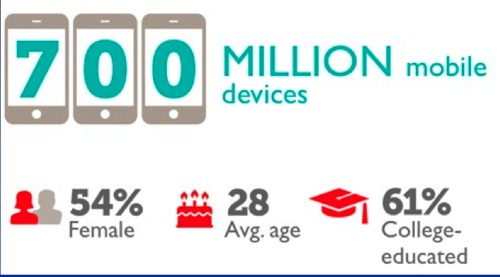Articles and News
HOW TO KEEP UP WITH THE EVOLVING LUXURY CONSUMER | April 10, 2013 (0 comments)

New York, NY—The baby boom generation, which has powered luxury jewelry buying for 65 years, isn’t quite history yet—but it is moving closer to the day when its 76 million members will be past their jewelry-buying years. And the much-discussed Millennials who will take their place as the primary driver of U.S. spending provide never-ending consternation for jewelers.
A webinar offered by the Plumb Club this week addressed the issue of keeping up with the evolving luxury consumer. Panelists were Pamela Danziger of Unity Marketing in Stevens, PA, a noted market researcher focusing on luxury; Martin Hurwitz of Paso Robles, CA-based MVI Marketing, and industry educator Kate Peterson of Performance Concepts in Canton, OH.
Danziger opened the session with a brief economic overview. While the economy is technically growing, it’s a slow recovery and still precarious, she believes, making the affluent “heavy lifters” of consumer spending even more important now than they were between 1980 and 2000. The top 20% of U.S. households (by wealth) are responsible for 50% of the nation’s income, 40% of its consumer spending, and control 90% of its discretionary income, she says, meaning that as the middle class grows weaker, the affluent will become even more important to all marketers, not just luxury marketers.
But income is only one-third of the story, she said. It’s important--it tells who can afford to spend—but psychographics tells what motivates people to spend, and observing their shopping behavior tells how they spend. Going forward, age is going to be more important than income in determining who is likely to spend, says Danziger. While the leading edge of the Millennial generation still is a few years away from the magic number of 35—the age at which consumers start hitting real affluence--young affluents (income above $100,000) spend approximately twice as much on luxury as mature affluents with equal income. Pay attention to those customers, she says, as well as younger ones with the education and ambitious career goals to become affluent in later years. Danziger has pegged 2020 as the year when luxury spending will really begin to rocket among Millennials.

According to Pam Danziger of Unity Marketing, young affluents spend nearly twice as much on luxury as mature affluents of the same income level.
Luxury retailers need to align their brand with young affluent consumers’ desires, says Danziger. And above all, their number-one desire is for fun. Work-life balance is far more important to these consumers than it was to their Boomer parents, says Danziger, and they are willing to make the tradeoffs necessary to have more time for hobbies, fun, and family. The trend is evident in increased spending on travel, music, flowers, luggage, recreation, motorcycles and airplanes, bicycles, sporting goods, and pets, she says. Additionally, this is a demographic that in order to have money and time for recreation is willing to forego a mansion and choose a more modest home (editor’s note: tightened mortgage lending since 2008 also may have something to do with this trend.)
This is a generation that wants to feel attractive, to attract, to bond, and, most of all, to feel that they’re getting value for what they spend. Their definition of value is a tough sell, too—they want more than they paid for, not just what they paid for—which has fueled the rise of warehouse clubs and outlet stores capturing share of market away from luxury boutiques, says Danziger. Additionally, she warned, Zales bumped Tiffany out of first place among luxury jewelry buyers’ destinations in her research last year.
Marty Hurwitz, CEO of MVI Marketing, says the way to the next generation’s heart—or at least to the forefront of their attention—is through their favorite games. This mobile, diverse, adventurous and self-confident generation will never shop the way their parents and grandparents did. Nearly half think they’re more informed than the store associate helping them, four out of five use mobile devices to shop, and by the end of this year the number of mobile devices on Earth will outnumber the people using them.
It goes without saying that consumers expect luxury marketers to have a website, but Hurwitz says this generation expects an e-commerce enabled site, not just an informational one. They also expect the site to be mobile-enabled, meaning it goes to a site designed for a mobile device, not just the ability to get to the standard site via a mobile browser.

Marty Hurwitz, CEO of MVI Marketing, showed this graphic outlining the market penetration and demographics of mobile devices.
The best way to reach these fun loving, super mobile customers will be through the games they play, and with a value-add, says Hurwitz. The highest click-through rates for digital advertising are for social and mobile gaming value exchange ads. These include a variety of options, including targeted, specific game buys, run of schedule, in-game billboards, and more.
Finally, industry sales expert Kate Peterson says jewelers need to completely rethink the way they’ve been trained to deal with a retail environment and the sales process. Instead of trying to contain the unpredictable behavior (chaos) that is a normal part of a retail environment, harness the energy of it. It requires an extremely high level of agility and adaptability—this is not the time to resist change but rather to embrace it and go with it. What used to be good enough no longer is, she said.
The traditional sales process most jewelers have been taught—and continue to teach—is greet, built rapport, profile, present, overcome objections, close, add on. This is done with product knowledge and highlighting features and benefits; i.e., tell the client then ask what they think.
Throw that out the window, says Peterson. It’s outdated and won’t work with today’s consumer.
Today’s consumer is a direct product of the “trophy generation,” she said. Older generations played a sport and got a trophy if they or their team won. In the Millennial generation, everybody gets a trophy, even if it’s just for showing up to practice. Hence, for this customer, “it’s all about ME.” Value is tied not to the product but to personal interest and need. Features and benefits must be personally and specifically applied for each customer—it’s not about what they spend but about what they personally get for what they spend.
It used to be that the day after high school graduation was the biggest day for engagement ring buying, says Peterson. It was the first big purchase a couple made. Not anymore—with the average age of first-time brides and grooms now 26.9 and 28.9, they’ve had a chance to make other big purchases, whether it was jewelry, a car, or even a house. They’re experienced purchasers, and when it comes to jewelry their first concern is looks—not the stone, not the price, but the look of the ring, and their loyalties are going to be based on previous fashion purchases.
There’s also no longer just one decision maker—these socially wired consumers involve everyone in their decisions: friends, family, even social media connections, and it’s no longer a linear process.
Peterson says these are the three keys to the new sales process:
- Ask before tell.
- Identify, don’t define, value.
- Respond, not recite.
Find out what’s important to them first. “What drew you to that particular ring?” This will lead you to find out their tastes, their preferences, what’s sentimental to them, what creates value in their eyes, and more. Become a problem solver and trusted advisor, not a product pusher.
It also drives the need for serious self-assessment, she says. Every salesperson, every storeowner should ask him or herself, “Am I becoming obsolete?” “How can I embrace change so I can perform at a higher level?”
Agile sellers are those who:
- Focus on selling skills, not the sales process.
- Justify the customer’s expectation of full value rather than just closing the sale.
- Understand the concept of personal value and look for the real value triggers for each individual customer.
- Sell what a product does [for the customer], not what it is [a beautiful piece with high intrinsic value].
For more information, log onto www.plumbclub.com.
Top image: www.groomsadvice.com







